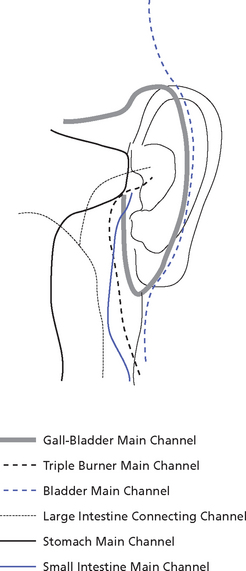Chapter 9 The ears are related to the Kidneys. Chapter 17 of the ‘Spiritual Axis’ says: ‘Kidney-Qi opens into the ears, when the Kidneys are harmonized the ears can detect the five sounds.’1 Chapter 5 of the ‘Simple Questions’ says: ‘The Kidneys govern the ears.’2 Chapter 37 of the ‘Spiritual Axis’ says: ‘The ears are the sense organ of the Kidneys.’3 Although the relationship between the ears and the Kidneys is very strong, other organs also influence the ears. For example, the Heart has an influence on the physiology and pathology of the ear. Chapter 4 of the ‘Simple Questions’ says: ‘The South corresponds to the colour red and to the Heart which opens into the ear.’4 The pathways of the channels flowing to the ears are summarized in Box 9.1 and illustrated in Figure 9.1. The normal ear should be first of all proportionate in size to the head, it should be relatively moist, its flesh should be full but supple and the helix should be pale red and moist. For a more detailed description of the patterns appearing in symptoms and signs related to the ears, see Chapter 57. The following ear signs will be discussed:
 OBSERVATION OF THE EARS
OBSERVATION OF THE EARS
INTRODUCTION
CHANNELS INFLUENCING THE EARS
OBSERVATION OF THE EARS




